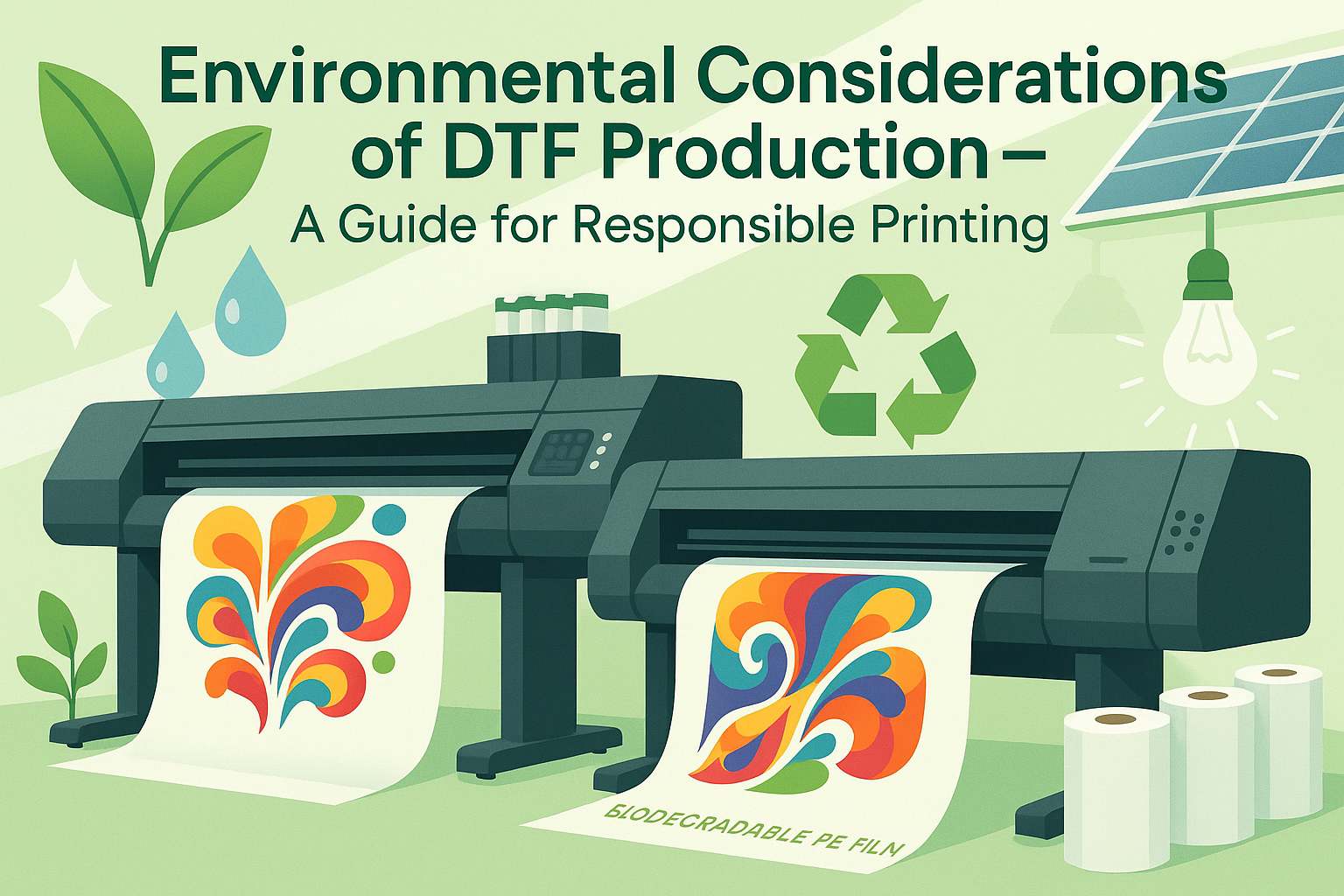As Direct-to-Film (DTF) printing continues to rise in popularity across the custom apparel and merchandise industries, many business owners are starting to ask an important question: How environmentally friendly is DTF printing?
Like all forms of printing, DTF production comes with its share of environmental concerns—from chemical usage to waste generation. However, compared to older or alternative methods, DTF presents opportunities for significant improvement in sustainability, especially when managed thoughtfully.
In this blog, we’ll explore the key environmental considerations of DTF production, how it compares to traditional methods, and practical ways your business can reduce its ecological footprint—without compromising on quality or efficiency.
Understanding the Environmental Impact of Printing Methods
Before diving into DTF specifically, let’s look at the big picture. Traditional printing methods like screen printing, sublimation, and DTG (Direct to Garment) have long been used in the apparel industry. However, they often come with environmental drawbacks, such as:
- Excessive water usage (especially in screen printing)
- Harmful chemicals and solvents
- High energy consumption
- Overproduction and waste
DTF printing offers a more streamlined process that reduces some of these challenges—but it’s not entirely impact-free.
Key Environmental Considerations in DTF Production
1. Ink Composition and VOC Emissions
DTF uses water-based pigment inks, which are less toxic than solvent-based alternatives often used in large-format or UV printing. However, the white ink in particular can contain more dense pigments and additives that contribute to volatile organic compounds (VOCs).
What You Can Do:
- Choose certified eco-friendly ink suppliers (like DTFSuperprint.com’s low-VOC formulas)
- Ensure good ventilation in print areas to protect both workers and indoor air quality
- Dispose of waste ink properly through hazardous waste collection—never pour it down the drain
2. PET Film Waste
DTF relies on PET (polyethylene terephthalate) film as a printing substrate. While this film allows for high-resolution transfers and clean releases, it is typically single-use and made of plastic.
What You Can Do:
- Use recyclable or biodegradable PET film when available
- Encourage manufacturers to innovate in film reclamation or take-back programs
- Collect and recycle PET waste through a local plastics recycling provider, if accepted
3. Hot-Melt Adhesive Powder
DTF powder contains thermoplastic polyurethane (TPU), which allows transfers to adhere to fabric. While effective, TPU isn’t biodegradable and may release fumes when heated.
What You Can Do:
- Use non-toxic TPU powders with lower melting points to reduce energy use
- Avoid overuse—automated powder shakers help limit excess
- Handle powders in ventilated areas with proper PPE (personal protective equipment)
4. Energy Consumption
DTF production involves heat curing and pressing, which require electricity. If you run high-volume operations, your energy usage can add up quickly.
What You Can Do:
- Invest in energy-efficient curing ovens and heat presses
- Use smart power strips and automated shutdown timers
- Switch to renewable energy sources where possible (solar panels, green power plans)
5. Overproduction and Material Waste
One major source of environmental harm in the apparel industry is overproduction—creating more inventory than you can sell. Fortunately, DTF’s on-demand capability allows for just-in-time production, reducing unsold stock and fabric waste.
What You Can Do:
- Print only what is ordered to avoid excess inventory
- Offer pre-order models or limited drops to forecast demand more accurately
- Use gang sheets to maximize film space and reduce scraps
DTF vs. Traditional Printing: Which Is Greener?
Here’s a quick breakdown of how DTF compares to common printing methods on environmental factors:
| Method | Water Usage | Chemical Waste | Fabric Flexibility | Waste Generation | Energy Use |
| Screen Printing | Very High | High | Medium | High | Medium |
| DTG | Medium | Medium | Low (mostly cotton) | Medium | High |
| Sublimation | Low | Low | Only synthetics | Low | Medium |
| DTF | Low | Medium | Very High | Medium | Medium |
As you can see, DTF offers several eco-friendly advantages—especially when compared to screen printing—but still presents areas for improvement.
How to Make Your DTF Printing Business More Sustainable
Sustainability isn’t just about avoiding harm—it’s also about creating long-term value for your business and customers. Here are five strategies to go greener with DTF:
✅ 1. Choose Sustainable Supplies
- Look for eco-certified inks and powders
- Choose low-waste packaging from your suppliers
- Use biodegradable or recyclable films when possible
✅ 2. Reduce and Reuse
- Reuse misprints as test transfers
- Cut unused PET film into smaller swatches for small jobs
- Offer a “seconds” section for slightly flawed prints at a discount
✅ 3. Educate Your Customers
- Include a note on your packaging explaining your eco-friendly efforts
- Encourage cold water washing and air drying to extend garment life
- Offer digital mockups to reduce physical samples
✅ 4. Upgrade Your Workspace
- Install LED lighting
- Use programmable thermostats in curing rooms
- Recycle cardboard cores, plastic film rolls, and ink bottles
✅ 5. Partner with Sustainable Brands
Aligning your DTF shop with environmentally conscious fashion or retail brands enhances your visibility and attracts eco-minded consumers. It also puts pressure on suppliers to innovate sustainably.
Looking Ahead: Sustainability Trends in DTF
As the industry evolves, expect to see exciting developments, such as:
- Biodegradable TPU powders
- Reusable film sheets with peelable adhesives
- Modular DTF machines with lower energy footprints
- Carbon offset programs offered by leading suppliers
At DTFSuperprint.com, we’re actively supporting efforts to make DTF greener—by sourcing eco-friendly consumables, offering bulk purchasing to reduce shipping waste, and providing guides on sustainable best practices.
Final Thoughts
DTF printing has opened the door to faster, more flexible, and on-demand apparel production. But with that power comes the responsibility to minimize its environmental impact.
By making smart choices around the materials you use, the way you produce, and the partners you work with, you can run a DTF business that’s both profitable and planet-friendly.Want to start printing smarter? Explore DTFSuperprint.com’s eco-conscious DTF inks, films, and powders today—and join the growing movement toward sustainable custom printing.

